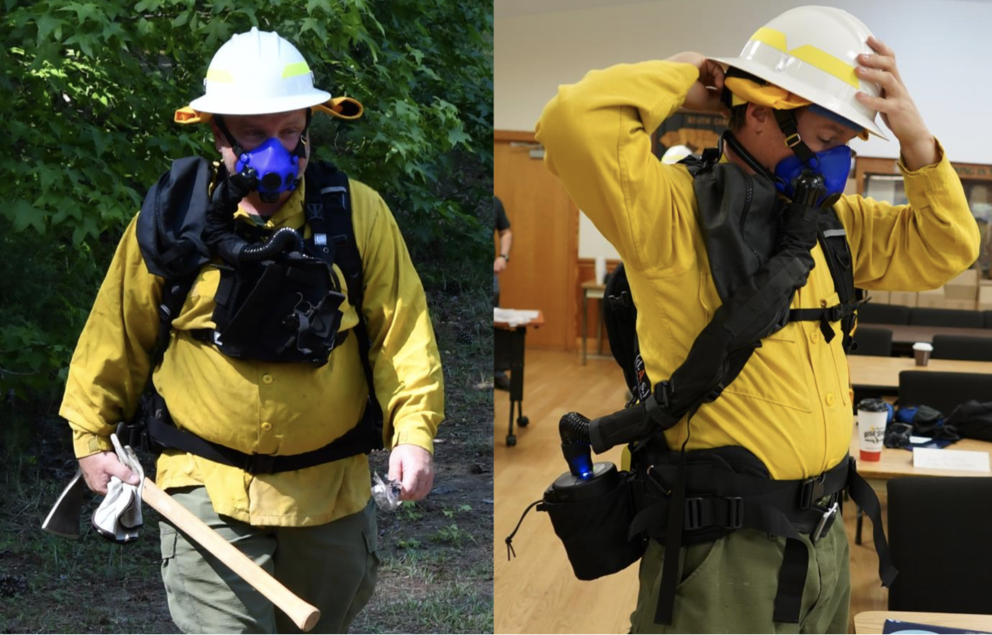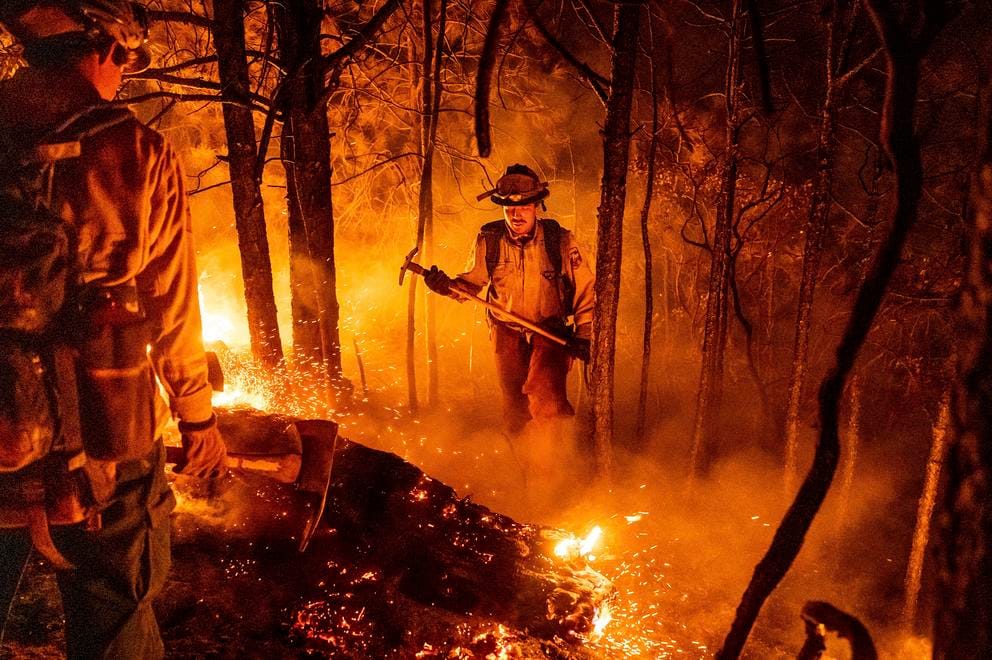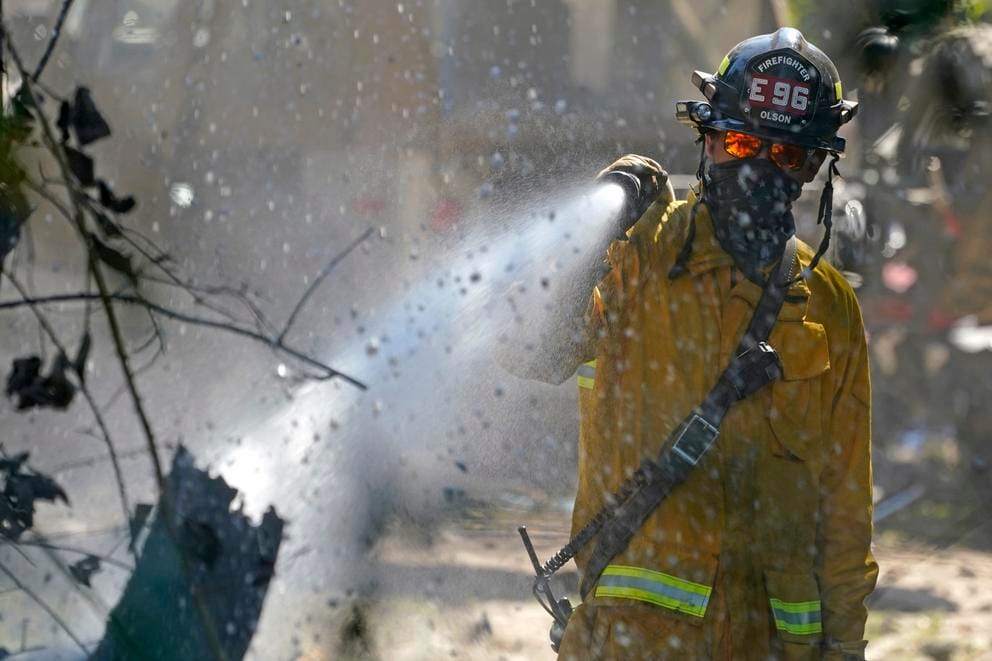Smoke lingered in the heat as fire Capt. Jeff Wainwright sweltered near Hangman Valley outside Spokane this past June. Baking in his bunker gear on a wildfire assignment, he caught a whiff of himself and realized the smoke was sticking to the open pores of his skin.
Back when he was a teen, Wainwright said, he wouldn’t have thought twice about being able to smell himself, but now at 53 with a family, it’s a different story.
“It’s just crazy to me how much toxicity is in our bodies,” said Wainwright, who chairs the Washington State Council of Fire Fighters’ wildland fire and mobilization committee. “I think back now and I’m like, we’re ticking time bombs.”
America’s wildland firefighters spend long hours exerting themselves in wildfire smoke, but haven’t worn respirators while tackling wildland fire in both remote and increasingly urban areas. Wainwright said he would if he could, but despite the danger, no one has ever manufactured a respirator suited to his job.
Plenty of respirators can help prevent smoke inhalation — think of those big, self-contained respirators structural firefighters wear in burning buildings, and even N95 masks. But none meet the physical demands of wildland firefighting, leaving wildland crews with little more than a bandana or loose shroud for protection. To date, no respirators meet the standards of both the National Institute for Occupational Safety and Health and firefighting’s leading advisory body.
This story is part of Crosscut’s WA Workplace Watch, an investigative project covering worker safety and labor in Washington state.
Wildland firefighters have long remained exempt from general state occupational safety regulations, most recently from the draft smoke protection rules for outdoor workers, as they operate under a separate safety code. After a decade of stalled development, public agencies in California plan to test new respirator prototypes this week in hopes of offering some long-awaited protection.
“There are times where you just don’t breathe, because you can’t,” Wainwright said. “It’s just been that way forever.”
As more wildfires roar into communities built in the wildland urban interface, where homes intermingle with densely managed forest, more firefighters face smoke filled with not only charred grasses and trees but also the toxic remnants of cars, houses and industrial facilities.
Wildfires blazed hotter for longer across more of the Pacific Northwest in the past decade, and more firefighters are fighting fires without sufficient protection. Climate scientists project that wildfire seasons will only become more severe in the hotter, drier future, and firefighter advocates are pushing industry to produce test models of wildland respirators using everything from regulatory pressure to grant funding.
It’s something that weighs on Washington State Forester George Geissler, who manages wildland firefighting for the Department of Natural Resources. He tries to place firefighters such that they’re as much out of the path of smoke as possible, but all firefighters on wildland assignments get exposed.
“Until we get something that is certified for use in this environment, there's nothing that we have, short of administrative options, for protecting them,” Geissler said. “The people potentially most exposed to wildfire smoke are the ones that have the least potential for protection.”
A slowly burning problem
Historically, wildland fires burned primarily in remote areas. But as people increasingly move into forested places, urban engine crews are responding to more of them.
That leaves more than 1 million firefighters exposed to wildland fire conditions. While DNR employs more than 1,300 people trained to fight wildfire, and federal agencies like the USDA and the Department of the Interior employ about 18,700 together, there are about 1.04 million career and volunteer firefighters spread across the country.
It’s a trend Albert “Al” Yanagisawa has noticed in the LA County Fire Department, where he is an assistant chief.

Evaluators participating in the Department of Homeland Security’s field test of a respirator intended for wildland firefighters are shown wearing the chest-mount and hip-mount versions, on May 20, 2022. DHS' National Urban Security Technology Laboratory is working with manufacturers like TDA Research to develop a Wildland Firefighter Respiratory Device (WFRD) capable of meeting both NIOSH and NFPA standards. (Courtesy of DHS)
While structural firefighters don large, self-contained breathing apparatuses to battle building fires, Yanagisawa said there hasn’t always been much concern about what wildland firefighters breathe in.
“The general belief was that if it’s a product of combustion in grass or trees, it’s natural,” he said. “What we’re finding now is, that might not be true.”
Even burning trees emit known carcinogens like PM2.5, fine particulate matter that can lodge deeply in the lungs and hasten cardiovascular disease. Wildfires also produce carbon monoxide, benzene, acrolein, formaldehyde and chemicals that structural firefighters face.
“The entire occupation of firefighting is a class one known human carcinogen,” said Michael Wilson, an industrial hygienist for California’s Department of Industrial Relations, known as Cal OSHA.
What’s more, dust and dirt carry hazards like valley fever fungus — one of Yanagisawa’s colleagues contracted the illness twice so badly that it almost killed him.
Wildland firefighters would ideally be able to wear the same masks and air tanks structural firefighters do to guarantee clean air. But those aren’t practical on wildland assignments.
SBCAs weigh around 30 pounds, and each air canister lasts about 15 minutes, Yanagisawa said. Wildland firefighters have to support themselves for nearly an entire day of strenuous work in rugged conditions, including hauling hand tools and water. The crews building firebreaks to prevent fire from spreading operate without an engine for up to two weeks at a time.
“A wildland firefighter is doing everything they can to conserve 8 ounces of weight and carry a little bit more water so they don’t dehydrate and die,” said Yanagisawa, who has opted against carrying cutlery in the field to make space for water.
Yanagisawa’s crews largely qualify as wildland urban interface firefighters: engine companies that respond to structure fires and medical aid calls outside of fire season. These crews provide backup to wildland firefighting hand crews for a few days at a time, spraying water on the emerging firebreaks from their engines and assisting hand crews on the ground. But even these crews can’t rely on heavy air tanks.
When it’s hot and the wind is blowing smoke, ash, embers, dust and sand in your face, it’s impossible to breathe and see, Yanagisawa said. “Imagine trying to run a sprint across a football field with 46 ounces of water, your tools, all your PPE which covers you from your fingertips to your toes.”

Firefighter Christian Mendoza manages a backfire, flames lit by firefighters to burn off vegetation, while battling the Mosquito Fire in Placer County, Calif., on Tuesday, Sept. 13, 2022. (AP Photo/Noah Berger)
Even smaller respirators, like N95s or P100s, can do more harm than good, making it harder to breathe and exacerbating heat stress.
“I’ve had to do CPR using a P100 and I can’t imagine digging fire line in that. It was hard enough to do CPR for two minutes,” Wainwright said. “Nothing that is on the market today allows enough air movement in and out of your body to be able to sustain [wildland firefighters]. We would have a bunch of guys passing out from hypoxia.”
But going without is no longer an option. Recent research by Interior researcher Kathleen Navarro shows that wildland firefighters face increased risk of dying from complications of cardiovascular disease and lung cancer, up to 43 percent and 30 percent respectively.
“They’re tired of dying or seeing friends die from cancer,” Yanagisawa said.
Government intervention
Nearly 20 years ago, the National Fire Protection Association received letters from academics and fire agencies requesting that it develop standards for a wildland firefighting respirator. If one existed, what would firefighters need it to be able to handle in the field? The advisory group published its first edition in 2011.
In 2012, NIOSH — which approves respirators generally but not for specific use cases — put out a call to private industry requesting submissions of respirators that met not only its own standards but also NFPA’s, known as NFPA 1984.
According to an unpublished NIOSH report drafted in 2014 and reviewed by Crosscut, it received no submissions. The report suggests that money was the key barrier.
“Manufacturers have not developed or submitted a respirator for certification due to the lack of demand and profitability,” the author wrote. “Until a large portion of the wildland firefighting community commits to purchasing a certified respirator, the demand is not great enough to justify production and liability costs.”
Multiple officials echoed the report's conclusions that manufacturers expressed a struggle to design respirators that would meet the established standards at a profitable cost. To date, NIOSH has never received a submission for a respirator that meets NFPA 1984 standards.
There are also cultural barriers to adoption. “There’s two things firefighters don’t really like: the way things are today, and change,” said Spokane’s Wainwright; even air packs took a while to catch on. Plus, many firefighters wear beards, and respirators simply don’t work well without a clean seal against people’s faces.
“Everything is pointing against you with this,” said Rick Swan, who was previously a deputy chief with Cal Fire’s San Luis Obispo unit, and director of health and safety operational services for the IAFF. “You’ve got firefighters that want something, but they don’t want what is out there. You’ve got people that want to produce them, but they’re thinking nobody’s going to buy them. And you have those [agencies] that would potentially buy them that don’t see a market because you’ve got firefighters that don’t want to use them. Nobody’s really lining up to do anything.”

A firefighter works to put out hotspots, Tuesday, Sept. 8, 2020, after a wildfire destroyed homes and outbuildings in Graham, Wash., overnight south of Seattle. (AP Photo/Ted S. Warren)
DHS put out a market research survey last year of 31 respirators that might work for wildland firefighters, but every firefighter Crosscut spoke with said none of them are practical for work beyond base camp.
When people like Yanagisawa ask manufacturers of respiratory equipment whether they can make a respirator that allows firefighters to work, hike and swing tools for up to two weeks at a time when they’re nowhere near a vehicle, “it’s almost as if we’re asking them to provide something for a firefighter who’s going to be on the moon for two weeks,” said Yanagisawa, who has served on the NFPA 1984 standards committee for nearly a decade. “It’s been like, there’s no manufacturer that makes the respirator so why are we focused so much on doing it?”
But some manufacturers are rising to the task — especially because, with help from federal agencies and the state of California, they might have a market soon.
The design push
Government agencies have tried to spur development through both funding and regulation.
A few years ago, the Department of Homeland Security started offering grants to manufacturers to design battery-powered respirators that pull clean air into firefighters’ face masks and ease the work of breathing. It granted company TDA Research at least $875,000 for research and development, with extended funding for design modifications. TDA has adjusted its design, previously mentioned in 2018 as a scarf-type respirator, over the years as it puts it through user research and testing.
But the state of California is using a more aggressive tactic.
Michael Wilson might be an industrial hygienist now, but before he started working on firefighter safety regulation, he himself was a firefighter in Salinas, California. He said he remembers people frustrated about the lack of respirators as far back as the 1990s.
After some of California’s most catastrophic wildfires on record, Cal OSHA decided to do something drastic: put a rule out there requiring that wildland firefighters had to wear respirators in two years, and start working on its own wildland respirator standard based on 1984.
“It was a kind of technology-forcing regulatory approach,” Wilson said.
The department issued draft language in May 2022, and there was a lot of resistance. The state agency, Cal Fire, called the regulation “crazy talk,” Wilson said. “They were like, first of all, you can't tell us what to do, and second of all, it’s impractical and unnecessary.”
But the California Professional Firefighters Association and IAFF were curious. So Cal OSHA pitched an idea: What if they did operational field assessments with some promising devices, to make sure firefighters actually liked them? Yanagisawa’s LA County jumped at the opportunity, and set up a formal partnership between state, county and federal agencies.
On Wednesday, the partnership will mark a big milestone. It’s hosting the first-ever large-scale test of five promising respirators, with real firefighters stepping in to do product testing, at the Del Valle Training Center north of Los Angeles.
The evaluators include 10 wildland firefighters from LA County, four engine company firefighters, two engine companies from Cal Fire, and six wildland firefighters from USFS. The firefighters will test three powered respirator models, from TDA Research, MSA and 3M, and two nonpowered models.
There won’t be any fire because they don’t know if these respirators work yet. But firefighters will run through jobs like pulling hose, cutting lines and connecting couplings to see how they feel.
Cal Fire is going to run its own tests with the same devices in mid-September, in Redding, California. Cal OSHA is still moving forward with writing its rule-making documents.
Despite interest from Northwest firefighters like Wainwright and others, a Washington Department of Labor & Industries spokesperson said he was not aware of any similar effort in the works in this state.
“We have to solve this problem,” Wilson said. “We cannot have another fire season where we’re just sacrificing people out there to do this job without giving them the right tool.”
Correction: This article was updated at 12:14 p.m. on Aug. 30, 2023 to reflect the full name of Cal OSHA is the California Department of Industrial Relations.



